Macroeconomics Assignment: Unemployment and Exchange Rates
VerifiedAdded on 2020/10/05
|7
|1228
|375
Report
AI Summary
This macroeconomics report delves into key concepts including different types of unemployment (frictional, seasonal, structural, and cyclical) and the advantages and disadvantages of fixed and flexible exchange rate regimes. The report also analyzes the impact of the Reserve Bank of Australia (RBA) increasing interest rates on the supply and demand for the Australian dollar. The analysis highlights how higher interest rates can lead to an appreciation in the value of the Australian dollar due to increased foreign investment. The report includes a diagram illustrating the relationship between RBA lending and deposit rates and concludes with a summary of the findings, referencing relevant academic sources.
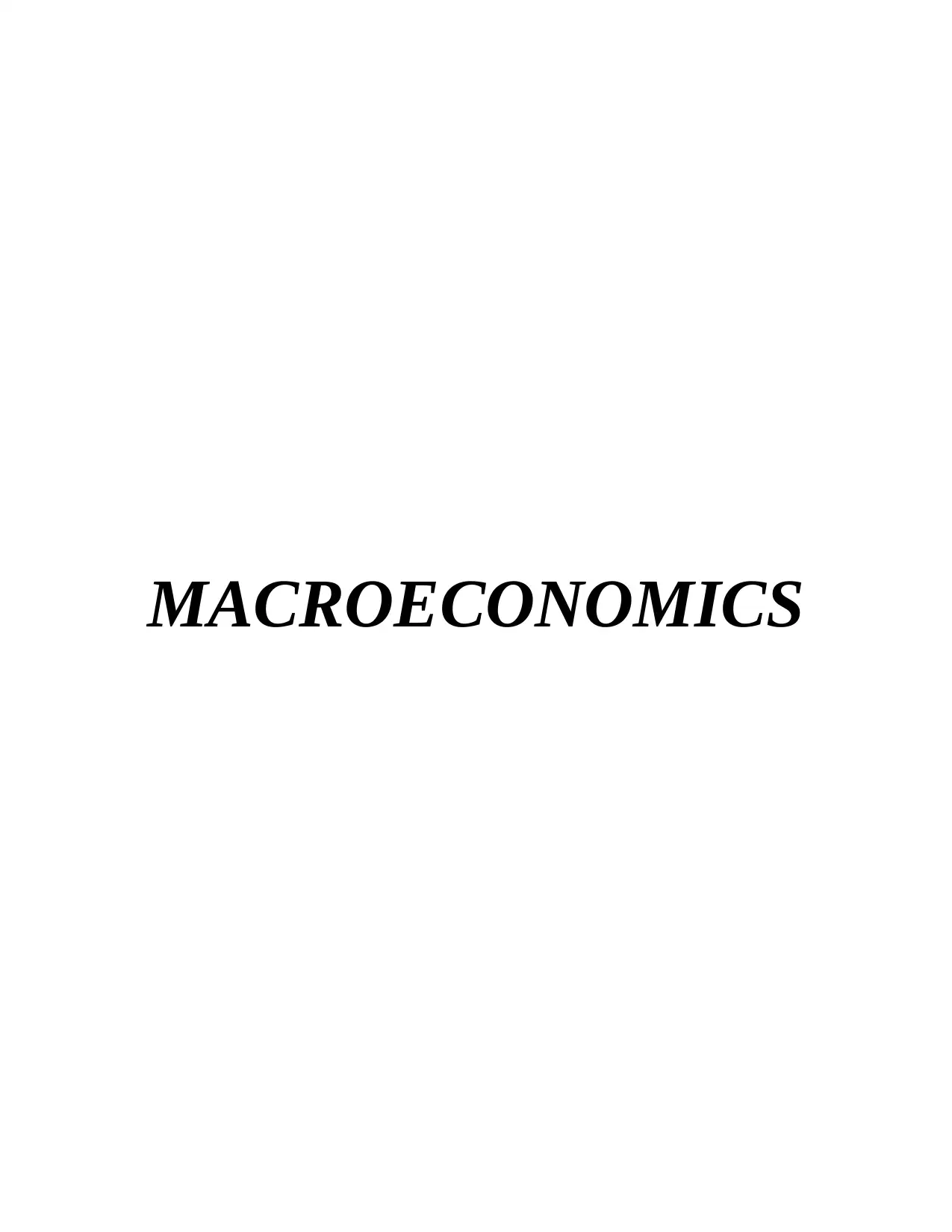
MACROECONOMICS
Paraphrase This Document
Need a fresh take? Get an instant paraphrase of this document with our AI Paraphraser
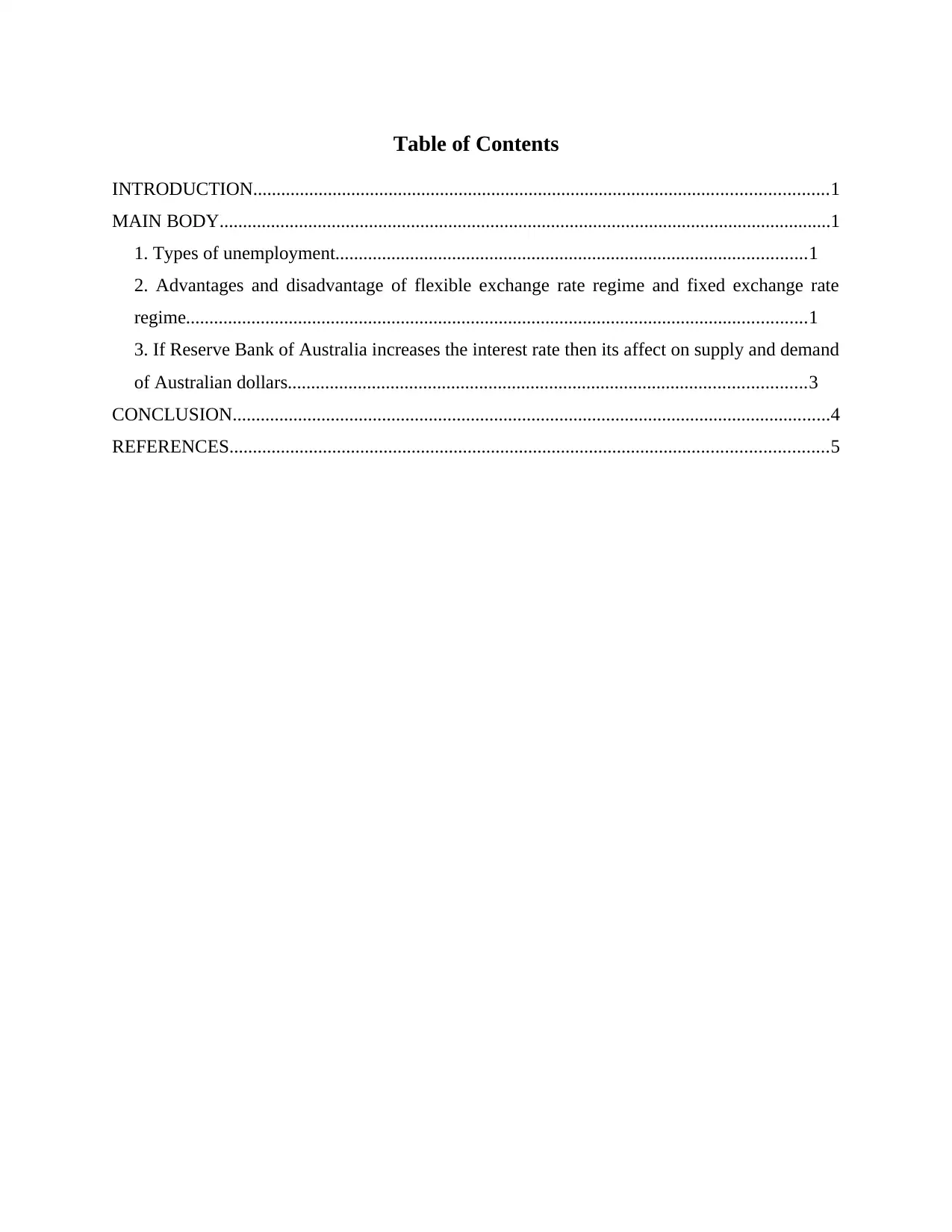
Table of Contents
INTRODUCTION...........................................................................................................................1
MAIN BODY...................................................................................................................................1
1. Types of unemployment.....................................................................................................1
2. Advantages and disadvantage of flexible exchange rate regime and fixed exchange rate
regime.....................................................................................................................................1
3. If Reserve Bank of Australia increases the interest rate then its affect on supply and demand
of Australian dollars...............................................................................................................3
CONCLUSION................................................................................................................................4
REFERENCES................................................................................................................................5
INTRODUCTION...........................................................................................................................1
MAIN BODY...................................................................................................................................1
1. Types of unemployment.....................................................................................................1
2. Advantages and disadvantage of flexible exchange rate regime and fixed exchange rate
regime.....................................................................................................................................1
3. If Reserve Bank of Australia increases the interest rate then its affect on supply and demand
of Australian dollars...............................................................................................................3
CONCLUSION................................................................................................................................4
REFERENCES................................................................................................................................5
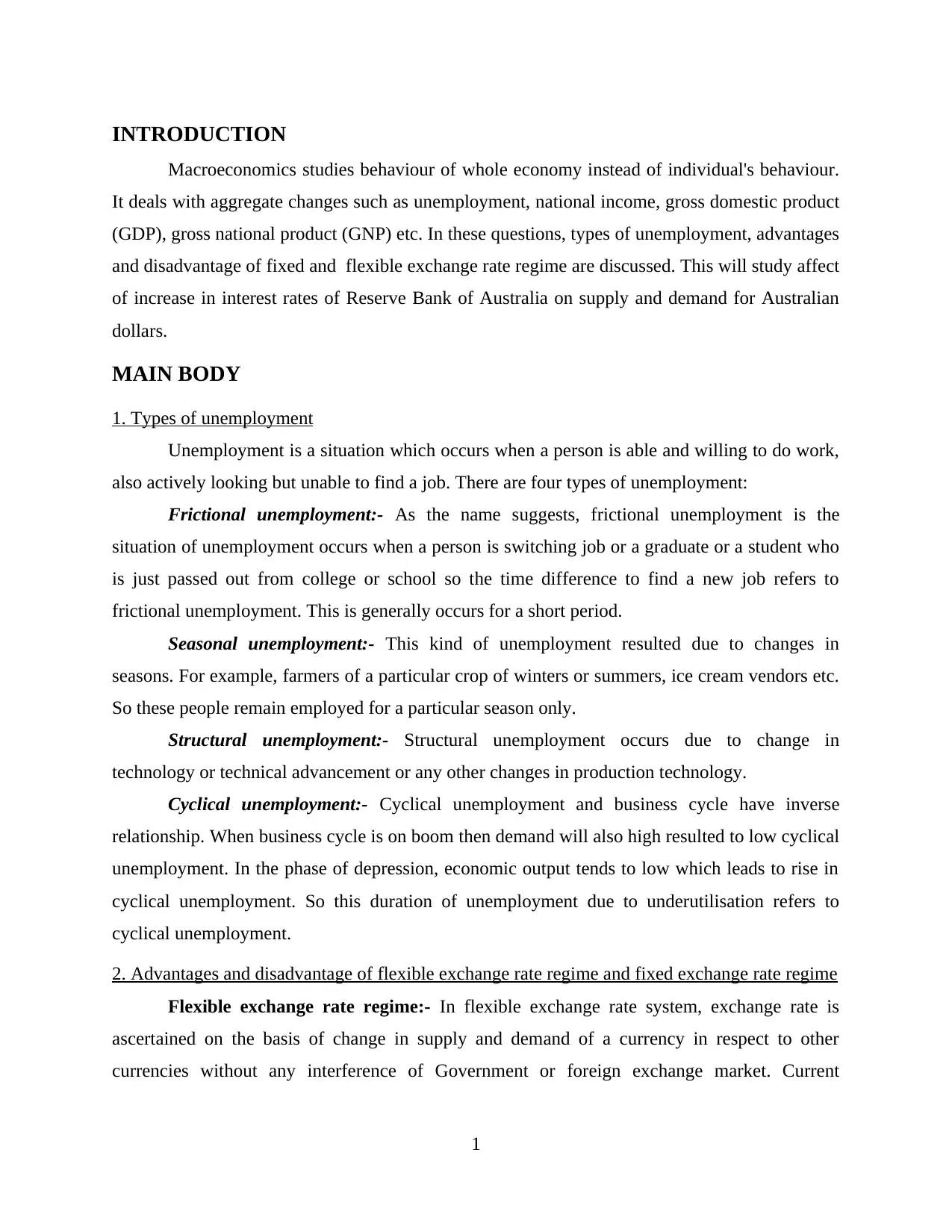
INTRODUCTION
Macroeconomics studies behaviour of whole economy instead of individual's behaviour.
It deals with aggregate changes such as unemployment, national income, gross domestic product
(GDP), gross national product (GNP) etc. In these questions, types of unemployment, advantages
and disadvantage of fixed and flexible exchange rate regime are discussed. This will study affect
of increase in interest rates of Reserve Bank of Australia on supply and demand for Australian
dollars.
MAIN BODY
1. Types of unemployment
Unemployment is a situation which occurs when a person is able and willing to do work,
also actively looking but unable to find a job. There are four types of unemployment:
Frictional unemployment:- As the name suggests, frictional unemployment is the
situation of unemployment occurs when a person is switching job or a graduate or a student who
is just passed out from college or school so the time difference to find a new job refers to
frictional unemployment. This is generally occurs for a short period.
Seasonal unemployment:- This kind of unemployment resulted due to changes in
seasons. For example, farmers of a particular crop of winters or summers, ice cream vendors etc.
So these people remain employed for a particular season only.
Structural unemployment:- Structural unemployment occurs due to change in
technology or technical advancement or any other changes in production technology.
Cyclical unemployment:- Cyclical unemployment and business cycle have inverse
relationship. When business cycle is on boom then demand will also high resulted to low cyclical
unemployment. In the phase of depression, economic output tends to low which leads to rise in
cyclical unemployment. So this duration of unemployment due to underutilisation refers to
cyclical unemployment.
2. Advantages and disadvantage of flexible exchange rate regime and fixed exchange rate regime
Flexible exchange rate regime:- In flexible exchange rate system, exchange rate is
ascertained on the basis of change in supply and demand of a currency in respect to other
currencies without any interference of Government or foreign exchange market. Current
1
Macroeconomics studies behaviour of whole economy instead of individual's behaviour.
It deals with aggregate changes such as unemployment, national income, gross domestic product
(GDP), gross national product (GNP) etc. In these questions, types of unemployment, advantages
and disadvantage of fixed and flexible exchange rate regime are discussed. This will study affect
of increase in interest rates of Reserve Bank of Australia on supply and demand for Australian
dollars.
MAIN BODY
1. Types of unemployment
Unemployment is a situation which occurs when a person is able and willing to do work,
also actively looking but unable to find a job. There are four types of unemployment:
Frictional unemployment:- As the name suggests, frictional unemployment is the
situation of unemployment occurs when a person is switching job or a graduate or a student who
is just passed out from college or school so the time difference to find a new job refers to
frictional unemployment. This is generally occurs for a short period.
Seasonal unemployment:- This kind of unemployment resulted due to changes in
seasons. For example, farmers of a particular crop of winters or summers, ice cream vendors etc.
So these people remain employed for a particular season only.
Structural unemployment:- Structural unemployment occurs due to change in
technology or technical advancement or any other changes in production technology.
Cyclical unemployment:- Cyclical unemployment and business cycle have inverse
relationship. When business cycle is on boom then demand will also high resulted to low cyclical
unemployment. In the phase of depression, economic output tends to low which leads to rise in
cyclical unemployment. So this duration of unemployment due to underutilisation refers to
cyclical unemployment.
2. Advantages and disadvantage of flexible exchange rate regime and fixed exchange rate regime
Flexible exchange rate regime:- In flexible exchange rate system, exchange rate is
ascertained on the basis of change in supply and demand of a currency in respect to other
currencies without any interference of Government or foreign exchange market. Current
1
⊘ This is a preview!⊘
Do you want full access?
Subscribe today to unlock all pages.

Trusted by 1+ million students worldwide
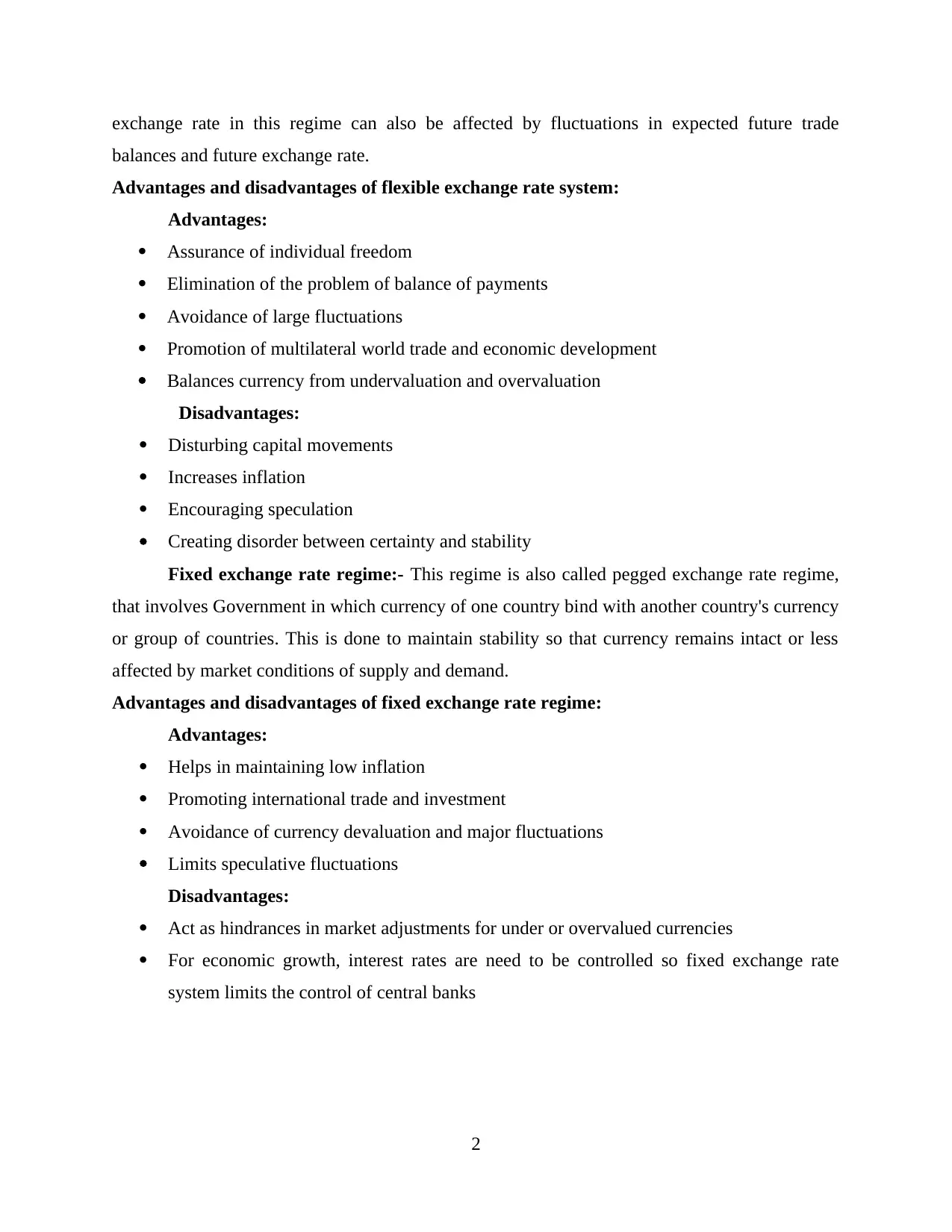
exchange rate in this regime can also be affected by fluctuations in expected future trade
balances and future exchange rate.
Advantages and disadvantages of flexible exchange rate system:
Advantages:
Assurance of individual freedom
Elimination of the problem of balance of payments
Avoidance of large fluctuations
Promotion of multilateral world trade and economic development
Balances currency from undervaluation and overvaluation
Disadvantages:
Disturbing capital movements
Increases inflation
Encouraging speculation
Creating disorder between certainty and stability
Fixed exchange rate regime:- This regime is also called pegged exchange rate regime,
that involves Government in which currency of one country bind with another country's currency
or group of countries. This is done to maintain stability so that currency remains intact or less
affected by market conditions of supply and demand.
Advantages and disadvantages of fixed exchange rate regime:
Advantages:
Helps in maintaining low inflation
Promoting international trade and investment
Avoidance of currency devaluation and major fluctuations
Limits speculative fluctuations
Disadvantages:
Act as hindrances in market adjustments for under or overvalued currencies
For economic growth, interest rates are need to be controlled so fixed exchange rate
system limits the control of central banks
2
balances and future exchange rate.
Advantages and disadvantages of flexible exchange rate system:
Advantages:
Assurance of individual freedom
Elimination of the problem of balance of payments
Avoidance of large fluctuations
Promotion of multilateral world trade and economic development
Balances currency from undervaluation and overvaluation
Disadvantages:
Disturbing capital movements
Increases inflation
Encouraging speculation
Creating disorder between certainty and stability
Fixed exchange rate regime:- This regime is also called pegged exchange rate regime,
that involves Government in which currency of one country bind with another country's currency
or group of countries. This is done to maintain stability so that currency remains intact or less
affected by market conditions of supply and demand.
Advantages and disadvantages of fixed exchange rate regime:
Advantages:
Helps in maintaining low inflation
Promoting international trade and investment
Avoidance of currency devaluation and major fluctuations
Limits speculative fluctuations
Disadvantages:
Act as hindrances in market adjustments for under or overvalued currencies
For economic growth, interest rates are need to be controlled so fixed exchange rate
system limits the control of central banks
2
Paraphrase This Document
Need a fresh take? Get an instant paraphrase of this document with our AI Paraphraser
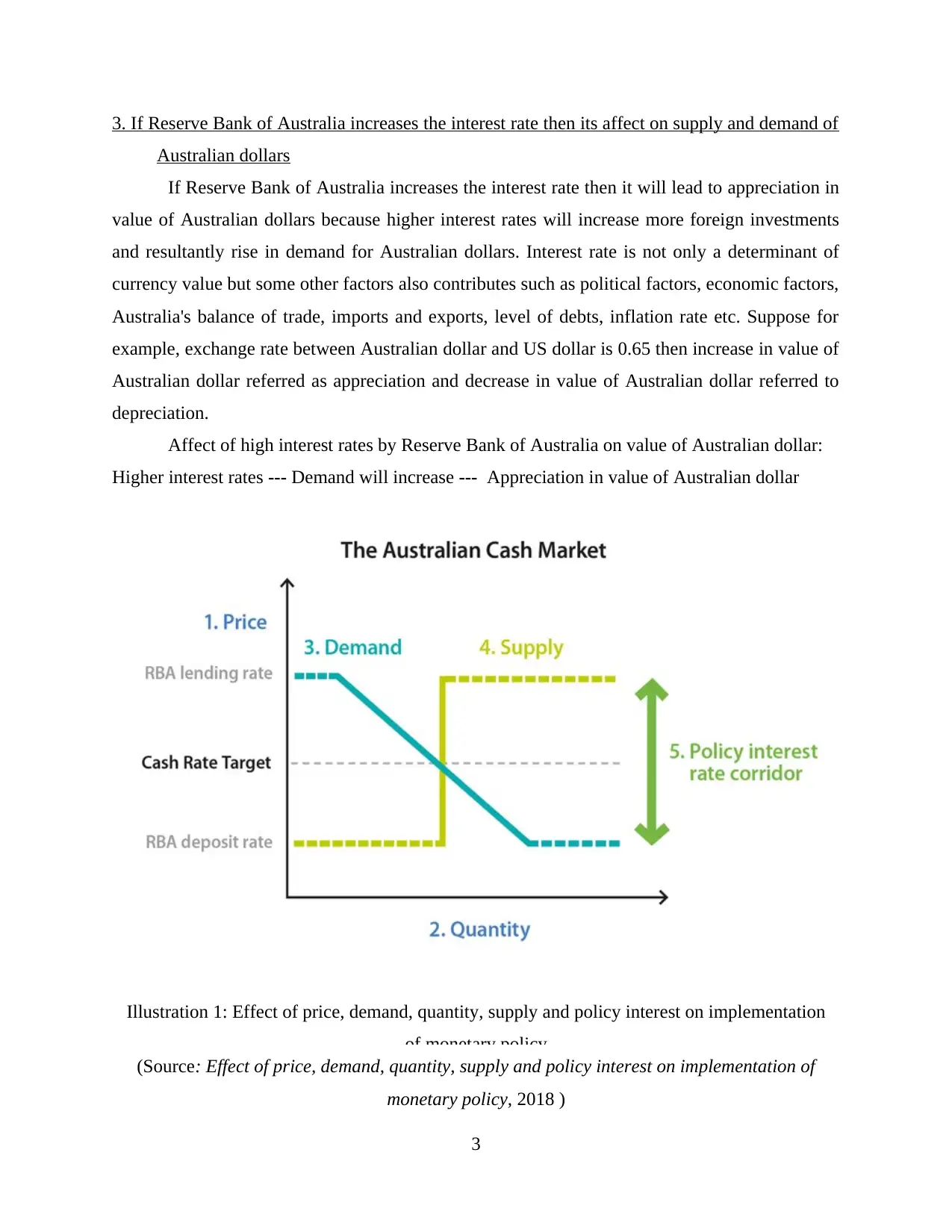
3. If Reserve Bank of Australia increases the interest rate then its affect on supply and demand of
Australian dollars
If Reserve Bank of Australia increases the interest rate then it will lead to appreciation in
value of Australian dollars because higher interest rates will increase more foreign investments
and resultantly rise in demand for Australian dollars. Interest rate is not only a determinant of
currency value but some other factors also contributes such as political factors, economic factors,
Australia's balance of trade, imports and exports, level of debts, inflation rate etc. Suppose for
example, exchange rate between Australian dollar and US dollar is 0.65 then increase in value of
Australian dollar referred as appreciation and decrease in value of Australian dollar referred to
depreciation.
Affect of high interest rates by Reserve Bank of Australia on value of Australian dollar:
Higher interest rates --- Demand will increase --- Appreciation in value of Australian dollar
Illustration 1: Effect of price, demand, quantity, supply and policy interest on implementation
of monetary policy
(Source: Effect of price, demand, quantity, supply and policy interest on implementation of
monetary policy, 2018 )
3
Australian dollars
If Reserve Bank of Australia increases the interest rate then it will lead to appreciation in
value of Australian dollars because higher interest rates will increase more foreign investments
and resultantly rise in demand for Australian dollars. Interest rate is not only a determinant of
currency value but some other factors also contributes such as political factors, economic factors,
Australia's balance of trade, imports and exports, level of debts, inflation rate etc. Suppose for
example, exchange rate between Australian dollar and US dollar is 0.65 then increase in value of
Australian dollar referred as appreciation and decrease in value of Australian dollar referred to
depreciation.
Affect of high interest rates by Reserve Bank of Australia on value of Australian dollar:
Higher interest rates --- Demand will increase --- Appreciation in value of Australian dollar
Illustration 1: Effect of price, demand, quantity, supply and policy interest on implementation
of monetary policy
(Source: Effect of price, demand, quantity, supply and policy interest on implementation of
monetary policy, 2018 )
3
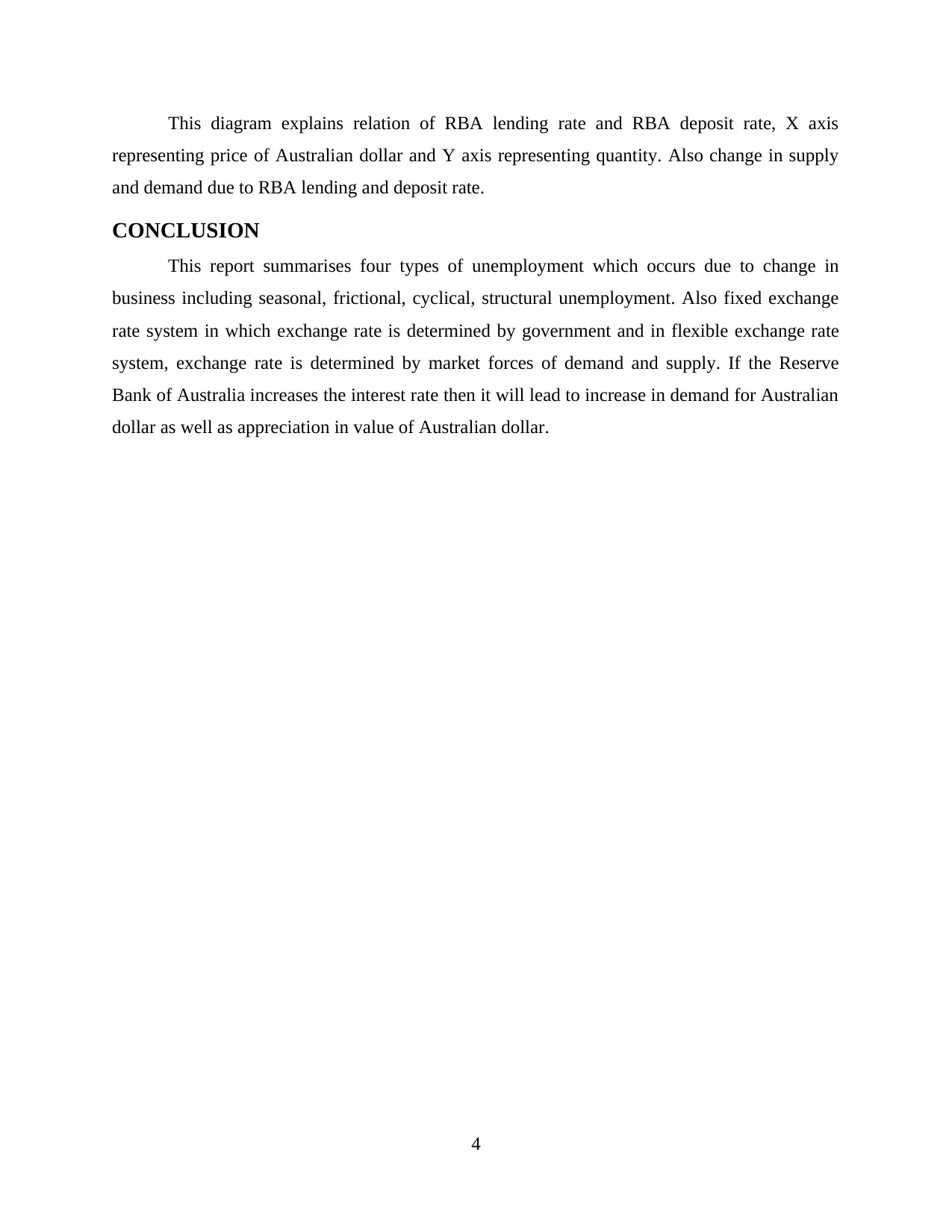
This diagram explains relation of RBA lending rate and RBA deposit rate, X axis
representing price of Australian dollar and Y axis representing quantity. Also change in supply
and demand due to RBA lending and deposit rate.
CONCLUSION
This report summarises four types of unemployment which occurs due to change in
business including seasonal, frictional, cyclical, structural unemployment. Also fixed exchange
rate system in which exchange rate is determined by government and in flexible exchange rate
system, exchange rate is determined by market forces of demand and supply. If the Reserve
Bank of Australia increases the interest rate then it will lead to increase in demand for Australian
dollar as well as appreciation in value of Australian dollar.
4
representing price of Australian dollar and Y axis representing quantity. Also change in supply
and demand due to RBA lending and deposit rate.
CONCLUSION
This report summarises four types of unemployment which occurs due to change in
business including seasonal, frictional, cyclical, structural unemployment. Also fixed exchange
rate system in which exchange rate is determined by government and in flexible exchange rate
system, exchange rate is determined by market forces of demand and supply. If the Reserve
Bank of Australia increases the interest rate then it will lead to increase in demand for Australian
dollar as well as appreciation in value of Australian dollar.
4
⊘ This is a preview!⊘
Do you want full access?
Subscribe today to unlock all pages.

Trusted by 1+ million students worldwide
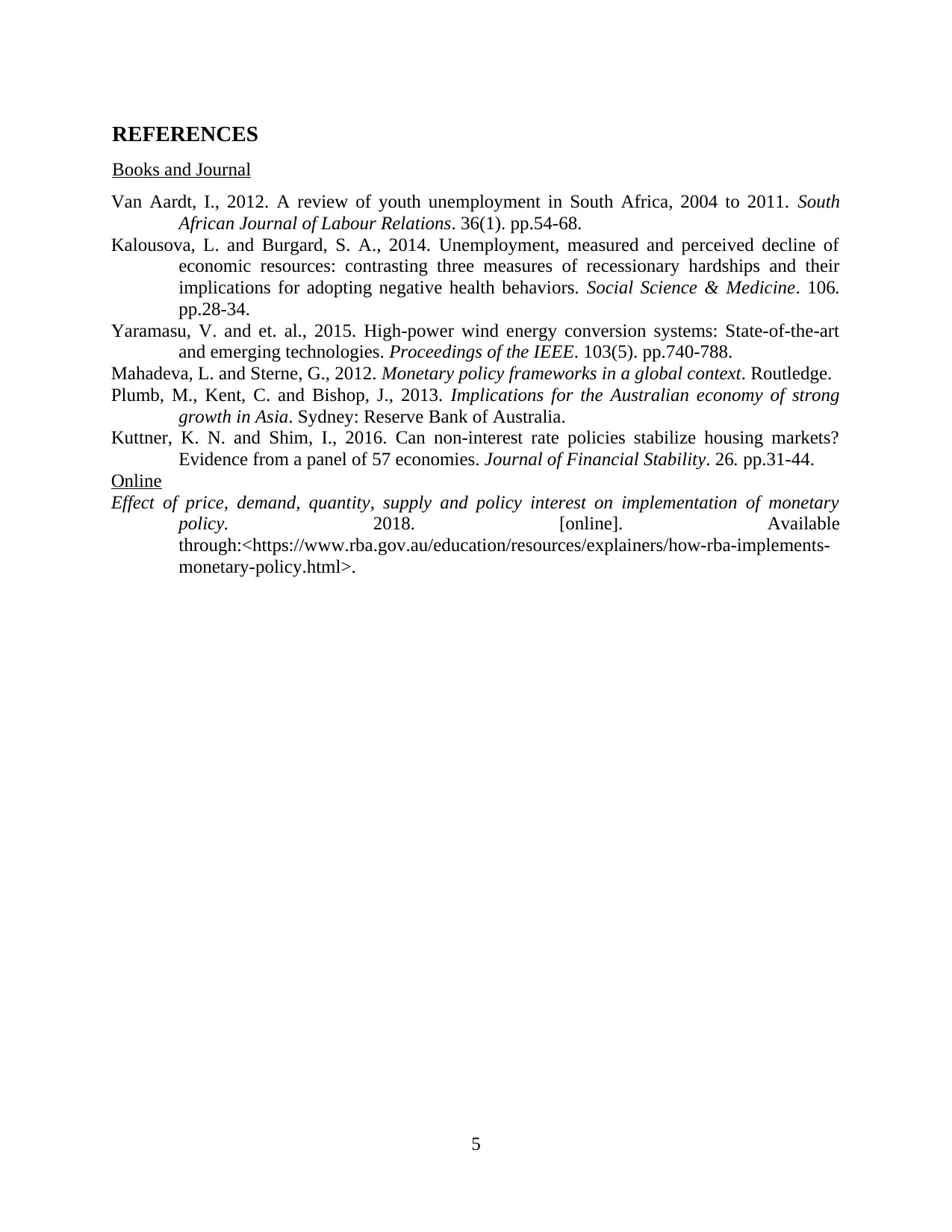
REFERENCES
Books and Journal
Van Aardt, I., 2012. A review of youth unemployment in South Africa, 2004 to 2011. South
African Journal of Labour Relations. 36(1). pp.54-68.
Kalousova, L. and Burgard, S. A., 2014. Unemployment, measured and perceived decline of
economic resources: contrasting three measures of recessionary hardships and their
implications for adopting negative health behaviors. Social Science & Medicine. 106.
pp.28-34.
Yaramasu, V. and et. al., 2015. High-power wind energy conversion systems: State-of-the-art
and emerging technologies. Proceedings of the IEEE. 103(5). pp.740-788.
Mahadeva, L. and Sterne, G., 2012. Monetary policy frameworks in a global context. Routledge.
Plumb, M., Kent, C. and Bishop, J., 2013. Implications for the Australian economy of strong
growth in Asia. Sydney: Reserve Bank of Australia.
Kuttner, K. N. and Shim, I., 2016. Can non-interest rate policies stabilize housing markets?
Evidence from a panel of 57 economies. Journal of Financial Stability. 26. pp.31-44.
Online
Effect of price, demand, quantity, supply and policy interest on implementation of monetary
policy. 2018. [online]. Available
through:<https://www.rba.gov.au/education/resources/explainers/how-rba-implements-
monetary-policy.html>.
5
Books and Journal
Van Aardt, I., 2012. A review of youth unemployment in South Africa, 2004 to 2011. South
African Journal of Labour Relations. 36(1). pp.54-68.
Kalousova, L. and Burgard, S. A., 2014. Unemployment, measured and perceived decline of
economic resources: contrasting three measures of recessionary hardships and their
implications for adopting negative health behaviors. Social Science & Medicine. 106.
pp.28-34.
Yaramasu, V. and et. al., 2015. High-power wind energy conversion systems: State-of-the-art
and emerging technologies. Proceedings of the IEEE. 103(5). pp.740-788.
Mahadeva, L. and Sterne, G., 2012. Monetary policy frameworks in a global context. Routledge.
Plumb, M., Kent, C. and Bishop, J., 2013. Implications for the Australian economy of strong
growth in Asia. Sydney: Reserve Bank of Australia.
Kuttner, K. N. and Shim, I., 2016. Can non-interest rate policies stabilize housing markets?
Evidence from a panel of 57 economies. Journal of Financial Stability. 26. pp.31-44.
Online
Effect of price, demand, quantity, supply and policy interest on implementation of monetary
policy. 2018. [online]. Available
through:<https://www.rba.gov.au/education/resources/explainers/how-rba-implements-
monetary-policy.html>.
5
1 out of 7
Related Documents
Your All-in-One AI-Powered Toolkit for Academic Success.
+13062052269
info@desklib.com
Available 24*7 on WhatsApp / Email
![[object Object]](/_next/static/media/star-bottom.7253800d.svg)
Unlock your academic potential
Copyright © 2020–2025 A2Z Services. All Rights Reserved. Developed and managed by ZUCOL.





